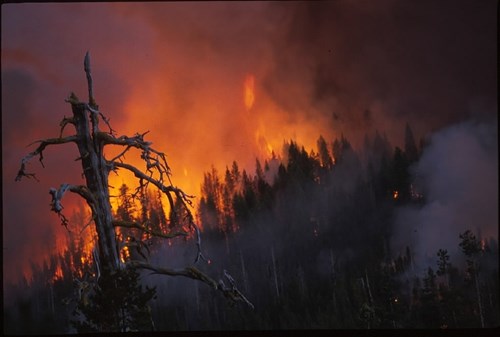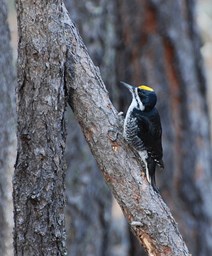Impact of Forest Fires, and Climate Change on the Nature
Wednesday, January 15, 2020Ecosystems around the world, such as the Canadian boreal forest and the Australian savannah, are adapted to natural disturbances like fire. In fact, these ecosystems have evolved over millions of years to take advantage of such natural disturbances. In Canada’s boreal forest, fire often promotes the growth of new trees by opening the canopy, clearing out dense woody vegetation, and dispersing seeds of species like lodgepole pine and jack pine, which have fire resinous cones. Ponderosa pine and Douglas fir create open forests in grasslands which can burn regularly. These trees have thick bark to protect themselves from fast moving grass fires. Bush fires in Australia also provide similar benefits, as Australia’s Eucalyptus trees are well adapted to fire disturbances and possess the ability to survive, recover, and regrow after fires – an adaptation mechanism that developed 62 million years ago. However, as the current media coverage of bushfires in Australia shows, out of control fire can be devastating to the natural and human world. In this blog, we will explore the implications of climate change in fire ecology, and in turn its impact on the natural world.
 Fire,Climate Change, and Wildlife
Fire,Climate Change, and Wildlife
Ecosystems adapted to fire disturbance are losing their ability to harness its benefits due to climate change, particularly in places like Canada and Australia. These two countries are getting warmer much faster than rest of the world due to their geographical positioning. The average surface temperature of Australia has increased by almost 1°C since 1910. Canada’s average surface temperature, on the other hand, has increased by 1.7°C since 1948. In comparison, the global mean temperature has only increased by 0.8°C since 1880. These rising surface temperatures result in more frequent severe weather including severe droughts and warmer conditions in different ecosystems. When fires occur, they are more intense due to the drier conditions and they spread rapidly. Intense fire burns the seed stock and even the organic matter in the soil, thereby, decreasing these ecosystems’ resiliency. In the United States’ Rocky Mountain range, scientists are beginning to find low tree regenerating post-fire. They are also finding an increase in post-fire seedling mortality. There is now a concern that some of these forested areas may never recover after fire disturbance, turning into non-forested area due to climate change. Similarly, in the Canadian boreal forest, spruce trees are being replaced by aspen due to climate change. In part this phenomenon is driven by low seed availability caused by the increase in fire frequency.
These changes have profound implications for wildlife. Wildlife occurring in fire prone ecosystems tend to be well adapted to these disturbances. In fact, species like Black-backed Woodpecker even benefit from forest fires. This particular species forges for insects in newly burnt forests, as well build their nesting cavities in charred trees. However, this does not mean that all species are equally resilient toward such disturbances. Woodland caribou, for example, are currently listed as a threatened species both federally and provincially in Alberta, Canada. While they prefer older conifer forest with abundant lichens, climate change is impacting Canadian boreal forest and instead of conifers, we see more and more deciduous forests growing in their place. This change of habitats will have serious impacts on caribou populations and recovery.
Many scientists believe that as the climate crisis worsens, increased forest fire frequency may not benefit any species, not even the well adapted ones. Consider the current bush fires in Australia. They have burned nearly ten million hectares (as of January 10, 2020), causing 25 human deaths and destruction of hundreds of properties. Some initial estimates (as of January 8, 2020) suggest that fires burning have killed over a billion mammals, birds, and reptiles. While many species like kangaroos are capable of escaping, others might not be so lucky. Koalas (species status: vulnerable), for example, seek safety from fire by climbing to the top of the eucalyptus trees. Under normal fire conditions, they can survive using this technique, however, current bush fires are burning so extremely hot that they have killed hundreds of koalas. All the while many threatened wildlife species are feared to have gone extinct. The primary reason for such severe fires is the extreme drought and heat-waves resulting in an increase in bush fire frequency, all caused by climate change.
What Can We Do?
A 2009 report by the Australian government predicted that due to climate change, southern Australia would experience extreme ‘fire danger days’ by 2020. As the current bush fires suggest, the Australian government, like many other world governments, failed to take a strong action on climate change – the result of which is unprecedent fires. In part, this lack of action is caused by climate change denialism. We need to, therefore, tackle denialism by educating ourselves and compassionately talking to climate change skeptics. You can learn about common denial arguments and the science of climate change by reading our previous blog. We can also take action at a more personal level to reduce our own carbon footprint. Fast fashion (cheap disposable clothing), for example, has become more prevalent in the recent years. One study showed that the average consumer bought 60% more clothing in 2014 than in year 2000. This rapidly growing industry has a huge environmental footprint, from water to carbon emissions. In 2015, clothes made from polyester produced a greenhouse gas emission equivalent of 185 coalfired power plants’ annual emission. We can reduce this environmental impact by simply wearing the clothes that we own longer, buying less, shopping at second-hand stores or by buying more environment friendly clothing such as wool and locally sourced cottons.
Picture Credit
80 trading 24, picture cropped, accessed on January 9, 2020, retrieved from https://commons.wikimedia.org/wiki/File:Bush_fire_at_Captain_Creek_central_Queensland_Australia..JPG
Foresfire3 by W:en:User:EIC. 18 Feb 2005. https://commons.wikimedia.org/wiki/File:Forestfire3.jpg
Male Black Backed Woodpecker. By Mike Laycock, National Park Services. 4 April 2013. https://commons.wikimedia.org/wiki/File:Male_Black-backed_woodpecker_(8618814179).jpg
Additional Reading
https://www.dpaw.wa.gov.au/management/fire/fire-and-the-environment/53-fire-plants-and-vegetation
https://www.agriculture.gov.au/abares/forestsaustralia/profiles/eucalypt-forest
https://biology.anu.edu.au/news-events/news/fire-adaptive-traits-eucalpyts
https://www.nature.com/articles/ncomms1191
http://www.bom.gov.au/climate/current/annual/aus/
https://changingclimate.ca/CCCR2019/
https://earthobservatory.nasa.gov/world-of-change/DecadalTemp
http://files.cfc.umt.edu/phiguera/publications/Stevens-Rumann_et_al_2018_Ecology_Letters.pdf
https://www.sciencedirect.com/science/article/abs/pii/S0378112711006827
https://www.cbc.ca/news/technology/forests-wildfires-1.4444998
https://esajournals.onlinelibrary.wiley.com/doi/pdf/10.1002/ecs2.2568
https://www.nrcresearchpress.com/doi/pdfplus/10.1139/cjfr-2019-0094
https://esajournals.onlinelibrary.wiley.com/doi/pdf/10.1002/ecs2.2472
https://royalsocietypublishing.org/doi/pdf/10.1098/rsos.150241
https://www.bbc.com/news/50986293
https://www.iucnredlist.org/species/16892/21960344
https://www.nationalgeographic.com/animals/2019/11/koalas-near-extinction-myth-australia-fires/
https://phys.org/news/2020-01-qa-climate-factors-stoke-australia.html
https://www.audubon.org/news/wildfire-benefits-many-bird-species
https://www.nytimes.com/interactive/2020/01/02/climate/australia-fires-map.html
https://www.environment.gov.au/climate-change/adaptation/publications/fire-regimes
https://www.wri.org/blog/2017/07/apparel-industrys-environmental-impact-6-graphics
Blog Posts
- What is Climate Change
- Drought: What Can We Do?
- Migration and Climate Change; a Complicated Relationship (Part 1)
- Migration and Climate Change; a Complicated Relationship (Part 2)
- Climate Change and Birds’ Resources
- Ladder to Extinction
- Arctic Warming and Ecosystem Impacts
- Climate Change Connection to Mountain Pine Beetle
- Tackling Climate Change Denialism
- Impact of Climate Change on Bluebirds
- An Introduction to Climate Change
- Great Decline of Aerial Insectivores
- Role of Oceans in Fighting Climate Change
- Role Of Forests In Fighting Climate Change
- Impact of Climate Change on Shorebirds
- Impact of Hurricanes and Climate Change on Birds
- An Introduction to Climate Change.
- Impact of Forest Fires, and Climate Change on the Nature
- Impacts of Climate Change on Owls
- Impacts of Climate Change on Birds of Prey
- Whitebark Pine and Clark's Nutcracker
- COVID 19 & The Environment
- Impact of Global Warming on Bird Anatomy and Colour Polymorphism
- Climate Change & West Nile Virus
- All Posts

